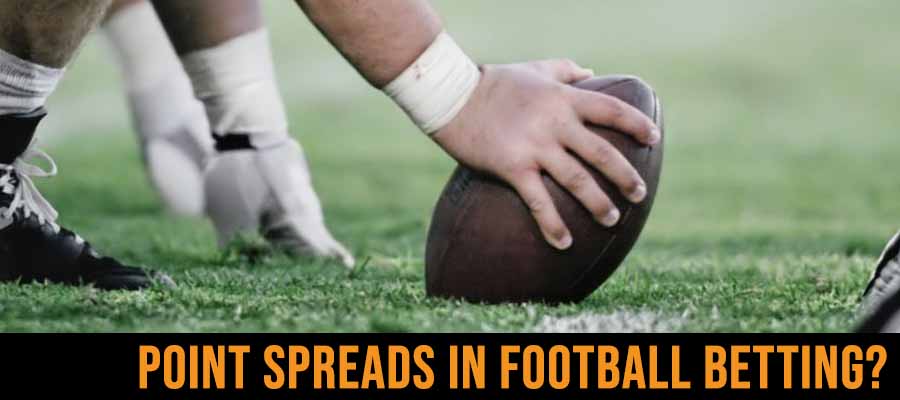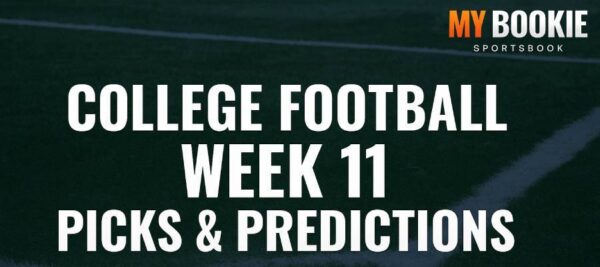Football betting fans use the point spread to win and that is why here at MyBookie, we want to show you how to profit from it today.
The point spread designed to provide more balance to a wager.
If the Seattle Seahawks, the 2025 NFC champions (and almost Super Bowl champions), open against the Tampa Bay Buccaneers to start the 2015 season.
There isn’t a point spread, the action would be heavily on the side of the Seahawks, because the Buccaneers are likely to be starting a rookie quarterback in Jameis Winston and emerging from a subpar season.
So you would see a point spread, something along the lines of this: Seattle (-10.5) at Tampa Bay.
Today, you will learn to place straight bets in football betting and learn how to make an accurate sports betting pick based on the point spread.
Mastering point spread betting is essential for anyone serious about wagering on football.
MyBookie Teaches You How to Use Point Spreads in Football Betting?
Sports Betting 101: Point Spread Secrets to Dominate Your Football Bets!
How to Bet on Sports | MyBookie wants you to be a better gambler with our Sports Betting Guide
Table of Contents: Point Spreads in Football Betting
What Does Point Spread Mean in Betting?
How to Read Point Spreads
What is Point Spread Betting?
The Role of Teasers in Point Spread Betting
Betting Point Spread vs. Moneyline: Key Differences
Understanding Point Spread Payouts
NFL Point Spread: Adjustments and Market Movements
Point Spread Betting Examples
Point Spread Betting Strategy: How to Win More Bets
Conclusion to Point Spread Betting in Football
What Does Point Spread Mean in Betting?
Point spread betting explained simply: the spread is a number set by oddsmakers that reflects how much one team is expected to win or lose by.
Rather than just picking the winner, bettors must decide if a team will cover the spread.
Understanding how does point spread work is crucial because it dictates whether you win or lose, not just who wins the game.
I Want to Bet Football: Why Do Need to Know This?
Betting on football is what makes the game greater, no doubt about that.
There are many ways for that, the one we are after today is point spreads.
These are designed to make games more even for the people betting on them.
Since they are used in NFL and College Football, understanding how point spreads work can help you make smarter bets.
The spread not only affects how you bet but also changes the way you watch the game.
It keeps games exciting even if the final score is not close.
The spread is a simple number, but it impacts how you think about each play, each quarter, and the final score.
What Will I Learn from this Betting Guide in Point Spreads in Football
This guide will explain what does point spread mean along with everything else you need to know.
You will learn what they are, how they work, and how to use them to your advantage.
What this means for you is that you will make better decisions and increase your chances of winning.
We will cover everything from the basics of spread betting to advanced strategies.
You will also find answers to common questions about point spreads.
By the end of this guide, you will be ready to place smart bets and understand the ins and outs of spread betting in football.
^ TopHow to Read Point Spreads
Learning how to read a point spread involves recognizing whether a team is favored (negative point spread) or an underdog (positive point spread).
For example, if a team has a -2.5 point spread, they must win by 3 or more points to cover.
If a team has a +2.5 spread, they can lose by up to 2 points or win outright to cover.
What does + point spread mean? It signals the underdog, giving you a few points of cushion.
Point spreads come with odds, usually shown as -110.
This is called the vig or juice.
It is the fee you pay to place the bet.
A -110 vig means you need to bet $110 to win $100.
The vig helps sportsbooks make money regardless of the outcome of the game.
It is an important part of understanding how much you can win and how much you need to risk.
The vig can change based on how much money is bet on each side.
If more money comes in on one team, the sportsbook may adjust the vig or the spread to balance the action.
This is why you might see different spreads at different sportsbooks or the same spread with different vigs.
Examples of Point Spread Bets
- If a team is -6.5
They need to win by 7 or more points to cover the spread. If they win by exactly 6, the bet loses. - If a team is +3.5
They can lose by up to 3 points or win outright. A loss by 4 or more points would mean the bet loses. - If the final score hits the spread exactly
Iit is called a push. In a push, your original bet is refunded, and you neither win nor lose money. - In live betting
Point spreads can change quickly based on the game’s progress, allowing for new betting opportunities during the game.
Point Spread Betting Explained: Key Rules and Variations
With football point spread explained, you’ll see that essential rules include the possibility of a push (when the final score difference matches the spread exactly).
Also, in NFL point spread betting, half-points like 2.5 or 3.5 are often added to avoid ties.
There are also alternate spreads where bettors can wager on different numbers for adjusted payouts.
^ TopWhat is Point Spread Betting?
A point spread is a number set by oddsmakers to make a game more balanced.
It shows how much one team is favored to win by.
The favored team must win by more than the spread for a bet on them to win.
The underdog can lose by less than the spread or win the game outright to win the bet.
For example, if the Kansas City Chiefs are -7 against the Denver Broncos, the Chiefs need to win by more than 7 points to cover the spread.
If the Broncos lose by 6 points or win the game, a bet on the Broncos would win.
The spread creates a balanced betting market where both teams have appealing betting options.
Point spreads are often shown with a number and a minus or plus sign.
How if Favorite? Look for that Minus
The minus sign (-) means the team is favored, while the plus sign (+) means the team is the underdog.
The spread makes games with clear favorites more interesting and offers better betting options.
It allows bettors to wager on either side of the game with reasonable odds.
The point spread is not just a random number.
Oddsmakers use detailed analysis, statistics, and historical data to set the spread.
They consider factors such as team performance, injuries, home-field advantage, and even weather conditions.
The goal is to create a spread that will attract balanced action on both teams.
How to Bet on Football Point Spreads
Betting on the spread is simple once you understand how it works and how it fits into your overall NFL strategies.
First, pick which team you think will cover the spread.
Then, decide when to place your bet.
Spreads can change before the game due to injuries, weather, and betting patterns.
One of the best strategies is to shop around for the best spread.
Different sportsbooks may offer different spreads or vigs on the same game.
Taking the time to compare can increase your potential profit or reduce your risk.
Consider timing your bet based on news and public betting trends.
If a star player is injured, the spread might move in response.
Likewise, if many bettors are backing one team, the sportsbook might adjust the spread to balance the bets.
This creates an opportunity to find value in the changing lines.
How Does Point Spread Work in Football?
The (-10.5) refers to the point spread.
If you choose Seattle Seahawks, you’re betting that they will not only win, but that they will win by 11 or more points, as there aren’t half-points in football.
The purpose of the half-point is to keep the bet from becoming a push.
If the line were 10, and Seattle won 31-21, then a push would result and all bets would be refunded.
If you choose Tampa Bay Buccaneers under this scenario, they can lose and you can still win – as long as they don’t lose by more than 10 points.
Let’s go for the example if the Seahawks are -10.5 against the Buccaneers:
If Seattle wins 31-20 → they win by 11 points → You win the bet
If Seattle wins 30-21 → they win by 9 points → You lose the bet
If Seattle wins 28-17 → they win by 11 points → You win the bet
If Seattle wins 24-14 → win by 10 points → You lose the bet
Because of the parity in the NFL, lines more than 12 or 14 points are fairly rare – which is much different than what you will see sometimes in college football.
Steps to Bet on a Point Spread
- Sign up at an online sportsbook.
Choose a site with good reviews and a solid reputation for payouts. - Make a deposit if needed.
Take advantage of any sign-up bonuses or promotions. - Find the football game you want to bet on.
Look at the spread and other betting options. - Choose the spread bet you want to make.
Decide whether to back the favorite or the underdog. - Enter your wager amount.
Be mindful of your bankroll and avoid betting more than you can afford to lose. - Place the bet and wait for the result.
Watch the game to see how your bet plays out and learn from the experience.
Key Terms to Know in Point Spread Betting
- Point Spread:
The margin by which the favorite must win or the underdog must not lose by, to cover the bet. - Cover the Spread:
When a team performs well enough against the spread to win the bet. - Favorite:
The team expected to win, represented with a minus (-) sign in the spread. - Underdog:
The team expected to lose, represented with a plus (+) sign in the spread. - Push:
When the result exactly matches the spread, resulting in a refund of the bet. - Vig/Juice:
The fee sportsbooks charge for taking the bet, usually shown as -110. - Alternate Spread:
A different spread offered with adjusted odds, allowing for customized bets. - Line Movement:
Changes in the spread or odds based on betting patterns or news. - Against the Spread (ATS):
Refers to how a team performs relative to the betting spread. - Hook:
The half-point in a spread (e.g., -3.5) that eliminates the chance of a push.
The Role of Teasers in Point Spread Betting
One variant is the teaser, which is a bet that changes the spread in the gambler’s favor by a set number of points.
In football bets, the teaser is often six points.
If the line is 4.5 points and the bettor wants to put a teaser bet on the underdog, he’ll take 10.5 instead.
If he’s betting on the favorite, he takes 1.5 instead of having to give 4.5.
To get these points, the gambler either has to take a payout of less than even money or make the teaser bet as part of a parlay, or a pair (or more) of bets that the gambler must win all of in order to get his winnings.
A reverse teaser goes the other way, elevating the payout should the gambler win.
Understanding how spread bets work is important to ensure that you don’t end up getting fleeced with your bet.
Before you accept a bet with a point spread, check your MyBookie account to have the most updated line of the game, then jump on it.
^ TopBetting Point Spread vs. Moneyline: Key Differences
When comparing spread vs moneyline bets, the biggest difference is that the moneyline only requires you to pick the winner—no point margin needed.
However, betting the spread often offers better odds if you are confident in how closely a game will be contested.
Deciding between betting point spread and moneyline comes down to your risk tolerance and how much you trust a team’s ability to win by a certain margin.
^ TopUnderstanding Point Spread Payouts
Point spread payout usually offers -110 odds, meaning a gambler risks $110 to win $100.
However, odds can shift depending on how the betting market reacts.
For example, a popular team might shift from -3 to -3.5, affecting both the spread and payout.
Knowing the basics of point spread odds helps you understand how your potential winnings can change before kickoff.
^ TopNFL Point Spread: Adjustments and Market Movements
The whole thing is designed to balance betting action for both sided.
Instead of betting on which team will win, the spread gives the underdog an imaginary head start (or the favorite a handicap).
If there isn’t balance on both sides of a bet, then the sports books aren’t going to make money – and they won’t offer the bet.
Remember, the books are in it for profits.
So over the course of a week leading up to a football game, you may see the line shift.
If the quarterback goes down to injury in practice for one team, then the line might shift dramatically.
If you find yourself on the wrong side of the action when the quarterback goes down, you’ll want to cancel your bet before the game starts.
If you’re on the right side when the surprise injury happens, and the line is even more in your favor, you’ll want to keep the bet.
As the week wears on after that news, the line will adjust to bring more balance to the bet.
For example, if a powerhouse like the Kansas City Chiefs(-7.5) is playing a struggling team like the Arizona Cardinals (+7.5), oddsmakers use the spread to encourage betting on both sides:
If you bet KC, they must win by 8+ points to cover the spread.
If you bet Arizona, they can lose by 7 or fewer, or win outright, and you’d still cash in.
This keeps bettors engaged, even if the actual game seems like a mismatch and protects sportsbooks from lopsided action by splitting the money.
^ TopPoint Spread Betting Examples
Here are point spread examples: If Team A is a -7 favorite against Team B, and they win 28-20, they cover the spread.
If they only win 24-21, they fail to cover, and bets on Team B win.
Knowing how does point spread work in football through examples helps bettors quickly grasp real-world scenarios.
The football point spread adds a dynamic layer of excitement to the game.
^ TopPoint Spread Betting Strategy: How to Win More Bets
A smart strategy starts with understanding point spread movements.
Injuries, weather, and betting volume can shift the spread, so timing your wager is critical.
Studying NFL point spread over under totals can also offer clues about expected game pace.
Keeping an eye on key injuries and betting market shifts can give bettors an edge.
Knowing how to bet point spread wisely is about much more than guessing.
^ TopConclusion to Point Spread Betting in Football
Mastering how to bet on football point spreads is a key part of becoming a successful football bettor.
By learning how to bet on NFL point spreads, understanding odds, reading the spread correctly, and applying smart strategies, bettors can increase their chances of success.
Whether you’re examining what’s the point spread for a Sunday matchup or refining your long-term approach, a disciplined and informed mindset will lead to better results over time.
Point spread betting is a great way to get more value from your football bets.
It keeps games exciting and offers many opportunities to win.
By understanding how spreads work and using smart strategies, you can improve your betting results.
Whether you are new to sports betting or looking to refine your approach, mastering point spreads is a key step.
Follow the tips in this guide, and you will be on your way to making smarter and more profitable football bets.
With practice and patience, you can turn point spread betting into a consistent part of your sports betting strategy.
Remember to always gamble responsibly and enjoy the thrill of the game.
^ Top
MyBookie’s Sportsbook Betting Guide | Point Spreads
Since you now understand the basics of point spread explained, take the next step by diving into more NFL betting tips at MyBookie’s Sports Betting Guide. It’s time to sharpen your knowledge and make smarter, more confident bets when wagering against the spread.
- Schedule Analysis And NFL Point Spread Winners
- How to Use Point Spreads in Football Betting?
- How NFL Point Spreads Work
- How to Bet on Sports: Point Spreads and NFL Betting
Sports Terms in this Page
What is the vig for the game or how much juice on the line…
Understanding points spreads or other betting terms can be tricky as many people assume that you know what you are talking about.
So, if you feel the need to polish that betting lingo, check out our Betting Glossary here at MyBookie.
We have the sports terms by letter and one whole one for numbers, so have a great time learning how to bet.
A | B | C | D | E | F | G | H | I | J | K | L | M | N | O | P | Q | R | S | T | U | V | W | X | Y | Z | 123Sports Betting Center
Sports Odds and Lines
| NFL Betting |
| College Football Betting |
| NBA Betting |
| College Basketball Betting |
| MLB Betting |
Sportsbook Odds | MyBookie Online
^ Top




